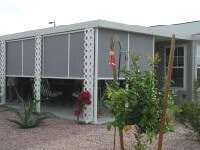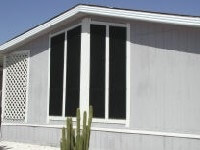Shade Screens
For Your Home And Patio
The material used for shade screens comes in a large variety of colors and sun protection properties. The extrusion used in the frames of sun screen can be matched to just about any screen color for a pleasing addition to your home.


Other uses for shade screens


Installing shade screens
Building and installing shade screens can vary in difficulty depending on the specific design, size, and complexity of the project. Here are some general considerations:
- DIY vs. Professional Installation: If you have basic construction skills and experience with home improvement projects, building and installing shade screens can be a manageable DIY task. However, it's important to assess your own capabilities and determine if you have the necessary tools, materials, and knowledge to complete the project safely and effectively. For more complex installations or larger-scale projects, it might be advisable to hire a professional installer to ensure proper installation and optimal performance.
- Design and Measurement: Before building or purchasing shade screens, accurate measurements of the windows, doors, or outdoor areas where the screens will be installed are crucial. This ensures that the screens fit properly and provide effective shading. Additionally, consider the orientation of your home and the path of the sun to determine the optimal placement and angle of the screens for maximum shade.
- Materials and Tools: Shade screens can be constructed using various materials such as fabric, mesh, or specialized solar screen materials. The choice of materials depends on factors like durability, UV resistance, and aesthetics. Additionally, you'll need appropriate tools like a tape measure, scissors or utility knife, screwdrivers, and possibly a drill for installation.
- Installation Methods: Shade screens can be installed using different methods, depending on the specific design and location. Some common installation techniques include attaching screens to existing structures using screws, brackets, or clips, or using tension systems to secure the screens. The installation process might involve working at heights, handling tools, and potentially working with ladders or scaffolding, so it's essential to prioritize safety and take necessary precautions.
- Instructions and Resources: If you choose to embark on a DIY shade screen project, it's advisable to follow manufacturer instructions or consult online resources that provide step-by-step guides or video tutorials specific to the type of shade screen you are installing. These resources can offer valuable tips and guidance throughout the process.
Remember, if you feel unsure about your abilities or if the project seems beyond your skill level, it's best to consult with professionals who can assist with installation or provide guidance. They have the expertise and experience to ensure the shade screens are installed correctly and effectively.
Need a roll of shade screen material? Solar Screen![]() . (#ad) Need screens built and installed in the Mesa Arizona
area? Just let me know.
Contact us here.
. (#ad) Need screens built and installed in the Mesa Arizona
area? Just let me know.
Contact us here.